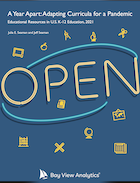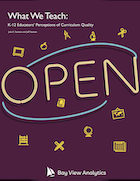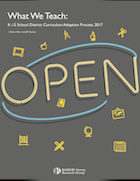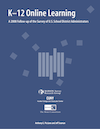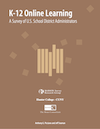K-12 Survey Reports
Presentation: Online Learning Consortium Innovate 24
UNDERSTANDING THE "WHAT" AND "WHY" OF K-12 INSTRUCTIONAL MATERIALS TO SUPPORT STUDENT SUCCESSDate: April 13, 2024
This research examines the spectrum of curricula materials employed in K-12 classrooms, differentiating between resources utilized by instructors and those intended for students. The presentation will focus on results from a national survey of K-12 teachers, investigating the differences between grade level and classroom subject as well as adoption and preferences for digital vs. print materials.
Overall, for student focused materials, student tablets or laptops and free online videos emerged as the most regularly used items. These are often utilized alongside self- or school-created quizzes/tests, additional reading, and homework assignments, available in both print and digital formats. While numerous materials see monthly use, daily materials are much less common.
Download presentation slides (PDF)
Coming Back Together: Educational Resources in U.S. K-12 Education, 2022
Infographic: Coming Back Together Infographic
While almost all teachers have returned to their classrooms this school year, the newest Bay View Analytics report Coming Back Together: Educational Resources in U.S. K-12 Education, 2022 shows that their reversion to textbooks and other physical instructional materials they preferred before the pandemic hasn’t been nearly as swift.
More than nine in 10 teachers reported having returned to in-person instruction. But only 30 percent of teachers report their instructional materials are entirely or predominantly physical, down significantly from 2018-19 prior to the pandemic when 68 percent said physical materials were the norm.
The continued use of digital materials comes despite most teachers (61 percent) saying they prefer to use physical materials and nearly the same number (59 percent) expressing a belief that students learn better with physical materials. However, most teachers (55 percent) also believe that their students prefer digital materials.
A Year Apart: Adapting Curricula for a Pandemic, Educational Resources in U.S. K-12 Education, 2021
Infographic: A Year Apart: Adapting Curricula for a Pandemic Infographic
A Year Apart: Adapting Curricula for a Pandemic is one of a series of annual surveys of K-12 teachers and administrators in the U.S. This report found that the sudden shift to remote instruction caused by the COVID-19 pandemic spurred significant and potentially lasting changes to the landscape of instructional materials. The majority of teachers were forced to make moderate or considerable curricula changes as they made the switch to remote instruction. Additionally, the results suggest that these changes, and increased adoption of digital tools in the classroom, are here to stay.
Key findings include:
- 74% of teachers reported that they were teaching remotely or using some combination of remote and in-person instruction; 58% of respondents reported having no prior online teaching experience.
- The new curriculum materials were acquired from commercial sources (33%) or were primarily developed by teachers (25%). Open-source curricula were used by 37% of districts for supplementary materials, and 97% of teachers used some form of video instruction.
- Teachers with prior online experience had greater awareness of open educational resources (OER) and licensing types; they were 14% more aware of Creative Commons and public domain, and 9% more aware or likely to have heard of OER.
What We Teach: K-12 Educators’ Perceptions of Curriculum Quality
A survey of 2,137 teachers, school-level administrators, and district administrator shows that they view the quality of curricula based on open educational resources (OER) as equal to offerings from commercial publishers. The research, conducted by Bay View Analytics, also shows a strong relationship between educators’ perceptions of the effectiveness of professional development on a curriculum and the quality of that curriculum.
- Three commercial publishers (Pearson, McGraw-Hill, and Houghton Mifflin) command the largest market shares for providing curricula materials, but together account for less than half of the adoptions.
- The number of districts designing their own curriculum is almost as large as the amount selecting from one of the top three publishers.
- OER adoptions are concentrated in Mathematics, where 14% of adoption decisions were OER, compared to 4% for English Language Arts, 2% for Science, and 1% for History and Social Studies.
- School districts are well-versed in including student technology use as part of the learning process.
What We Teach: K-12 School District Curriculum Adoption Process, 2017
Over three-quarters of K-12 districts have made at least one full-course curricula adoption decision over the past three years, with the need to meet changing standards driving most of these decisions, according to the results of a new survey from the Babson Survey Research Group.
The project, funded by a grant from The William and Flora Hewlett Foundation, surveyed a national sample of over 500 decision makers in K-12 school districts to examine the process by which they made curriculum adoption decisions and the extent to which open educational resources (OER), freely available materials that can be copied, edited and shared, factor into those decisions. Key findings from the report include:
- The overwhelming reason districts cite as the reason to engage in an adoption decision is a need to select new material to meet changing standards.
- Teachers have decision-making power in the adoption process for 94% of districts, followed by district-level administrators (75%), and principals (73%).
Online Learning in Illinois High Schools: Has the Time Come?
Online education is increasingly being embraced by Illinois high schools, according to the first ever, in-depth, state-wide study of the role of online education. Using data collected from over 200 Illinois high school principals, the study found that administrators see online learning as meeting the diverse needs of their students whether through advanced placement, elective college courses, or credit recovery.
The major reason cited for online and blended offerings is to provide courses that otherwise would not be available. Concerns that online learning is not as effective as face-to-face instruction remain, yet high school administrators see benefits to online learning programs that overshadow concerns about pedagogical value.
Other key findings include:
- Credit recovery (for students to make up courses that they did not complete) is the most popular type of online course being offered among Illinois high schools.
- Urban high schools, which historically have the lowest graduation rates, are embracing online credit recovery as a basic part of their academic offerings.
- High school administrators consider online elective college-level courses as an effective means for the more able students to begin their college careers.
- Rural schools are in the vanguard in offering online and blended learning programs to their students—using online courses to overcome significant problems in funding, teacher certification, and small enrollments.
Included as a chapter in Exploring the Effectiveness of Online Education in K-12 Environments, edited by Tina L. Heafner, Richard Hartshorne and Teresa Petty (https://www.igi-global.com/book/exploring-effectiveness-online-education-environments/105957).
Class Connections: High School Reform and the Role of Online Learning
Using data collected from a national sample of over 400 high school principals, the study Class Connections: High School Reform and the Role of Online Learning (pdf) found that these administrators see online learning as meeting the diverse needs of their students whether through advanced placement, elective college courses, or credit recovery. The major reason cited for online and blended offerings is to provide courses that otherwise would not be available.
Concerns that online learning is not as effective as face-to-face instruction remain, yet high school administrators see benefits to online learning programs that overshadow concerns about pedagogical value-the vast majority of their schools are moving forward with their programs and looking to expand them in the future.
K–12 Online Learning: A 2008 follow-up of the Survey of U.S. School District Administrators
The purpose of K–12 Online Learning: A 2008 follow-up of the Survey of U.S. School District Administrators (pdf) is to replicate the 2005–2006 study in order to substantiate its findings and to examine what, if any, changes occurred in online learning in K–12 school districts. The study found that online and blended learning grew by 47% between 2005-2006 and 2007-2008. Every indication is that this growth will continue in the foreseeable future. If K–12 follows the pattern of enrollment growth in higher education, it is quite possible that online learning will emerge as a substantial component of all learning at the secondary level.
K–12 Online Learning: A Survey of U.S. School District Administrators
K–12 Online Learning: A Survey of U.S. School District Administrators (pdf) reports that almost two-thirds of the responding public school districts are offering online courses; over the next two years districts predict online enrollments will increase by 19% and blended enrollments by 23%. Small rural schools may be providing important experiences for school districts in other localities, especially those that are facing severe teacher shortages. It is also possible that the blended model may prove to be attractive to K–12 schools, especially those that are struggling with issues of online learning quality, student readiness, and teacher professional development. Finally, online learning is not one thing but comes in various shapes and sizes.
Recent Publications
Open Educational Resources
- Approaching a New Normal? Educational Resources in U.S. Higher Education, 2024
- Conflicted Digital Adoption: Educational Resources in U.S. K-12 Education, 2024
- Research Brief: Digital and OER Textbook Adoption
- Research Brief: Faculty Satisfaction with Course Materials varies by Publisher
Course Material Affordability
Digital Learning Pulse Surveys
- Infographic: 2023-2024 Digital Learning Pulse Survey
- The Digital Transformation of the Community College
- Planning for a Smaller Future: Dealing with Declining Enrollments
STEM
- Teaching Online: STEM Education in the Time of COVID
- What Makes a STEM Student
- Perceptions of the Future of STEM Education
Distance Education
- Digital Faculty: Faculty Social Media Use and Communications
- Infographic: Digital Faculty
- Grade Increase: Tracking Distance Education in the United States
Follow us on
Privacy
All survey respondents are provided complete anonymity. No personally identifiable information is released. Full privacy policy.

